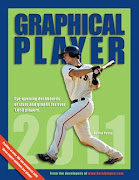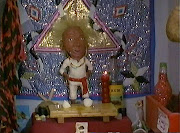 A lot of things have gone wrong for the Tribe this season. The heart of the order has spent most of the season on the disabled list. Injuries to the starting rotation have given way to open tryouts. Many of these blips you just can't build into the off-season shopping list. Every time I go through the long list of things that have gone haywire though, I keep getting hung up on the bullpen.
A lot of things have gone wrong for the Tribe this season. The heart of the order has spent most of the season on the disabled list. Injuries to the starting rotation have given way to open tryouts. Many of these blips you just can't build into the off-season shopping list. Every time I go through the long list of things that have gone haywire though, I keep getting hung up on the bullpen.The bullpen is tricky because on one hand it appeared strong in the off-season and you can only dump so much money into what would likely amount to insurance policies. On the other hand, it should have been obvious to the experts in the Front Office (not so much to me as I'm obviously not an expert on anything) that some of the pillars holding up the relief corps were baring a few cracks.
Cleveland's bullpen was one of the best in the Majors last year and boasted a 3.75 ERA, 1.33 WHIP, and 49 saves. Betancourt had a career year and was the undisputed king of the 8th inning. Rookies Rafael Perez and Jensen Lewis made an impact in the late innings and seemed primed to contribute in 2008. I personally hyped up the arrival of Masahide Kobayashi as a key addition for 2008 based on his experience as a closer in Japan. The Front Office was very familiar with the volatility of relief pitching, but the pros appeared to outweigh the cons with the Tribe's bullpen core heading into 2008.
Like every off-season, risk assessment is a big part of deciding how heavily to lean on certain players and how much money to spend. Cleveland took a gamble with Joe Borowski's arm and it backfired; there's not much else to it. The team certainly didn't go in without a backup plan though, far from it. In fact, I advocated making Kobayashi the closer once Borowski went down (oops). Masa was added as depth for the pen and I feel that the Tribe got him as a backup in case a late inning role became vacant. Masa's backup role (speculation on my part) was never officially stated by the team, not that anyone expected them to say something like that with Borowski's name still at the top of the depth chart.
Borowski went down with a triceps strain in May and never regained his lost velocity (the velocity was down before, but the injury didn't help). Borowski saw three more save opportunities in June before being released July 1 (he ended up on a minor league contract with Boston, but has not contributed in the Majors again).
Cleveland's first line of defense in case of a Borowski implosion was Rafael Betancourt. Betancourt was the interim closer from late April to the end of May. Raffy didn't take well to the closer's role, but I think that was more reflective of his struggles in the entire first half than anything else. Betancourt posted a 6.38 ERA, 1.48 WHIP, 4.33 K/BB ratio, and converted 4/6 saves over 14.1 IP during his initial foray into closing from April 24 to May 28.
I still think Betancourt has what it takes to be an effective closer, but it was a matter of the wrong guy at the wrong time in 2008. Betancourt's 6.00 ERA before the All Star break made it clear that he was not pitching at 100% and really wasn't a viable option for closer at the time. Granted, the team was desperate and probably just following their plan; somebody had to pitch the final inning with Borowski hurt.
Kobayashi was the primary closer from mid May to late July, but it soon became clear that the transition to the Majors and, more importantly, the career high in innings was taking its toll. Kobayashi posted a solid 3.05 ERA, 1.15 WHIP, 2.54 K/BB ratio, and converted 5/7 save opportunities in 44.1 IP before the All Star break. Kobayashi has only exceeded 50 IP in his career three times in nine Pro Yakyu seasons ('01, '04, '06). It may be coincidental, but Masa's two highest season ERA's in Japan occurred when he pitched 52 (4.33 ERA) and 57 innings (3.90 ERA), respectively. I think these ERA spikes are notable in that Kobayashi owns a career ERA of 2.79 in the Pro Yakyu League.
As the 34 year old Kobayashi crept toward the 50 IP mark in his rookie season his pitches began to lose some of their effectiveness, resulting in more multi-run innings. Cleveland opted to cut Masa's innings in the second half from an average of 12.12 per month from April to July, to just 3 each in August and September.
It appears that Cleveland may have been banking too much on Betancourt and Kobayashi (assuming they viewed him as a major cog for 2008). I don't think it's a matter of hindsight either, since certain information was available during the off-season. One point that I had alluded to in a previous post was Betancourt's innings load last season.
After shattering his career high in IP of 67.7 (2005) by 21.6 (includes post season) and throwing so many high leverage, stressful innings in 2007, common sense would dictate that something had to give.
I'm not talking about a typical regression (that was already obvious given Raffy's god-like numbers), I'm talking about a more drastic change be it a tired arm or more serious injury. Raffy's performance clearly shows something went wrong between 2007 and 2008. My theory is that he's had a nagging injury all season that was precipitated by his being the bullpen's workhorse last year. This would match up with reports of back stiffness and an obvious loss of control (career worst 2.52 K/BB ratio in 2008). I don't know how much concern Betancourt's 2007 work load caused the team, but it seems like Betancourt was supposed to be the key to the bullpen a second straight year.
Besides the announced back issue, I still can't pinpoint what may be bothering Betancourt. Considering the team signed him to a three year deal last winter, you'd think they'd have shut him down at this point in a lost season if he had a truly serious injury. Maybe he's not hurt and the best thing is for him to work out whatever control issues he's having, I honestly don't know.
There was risk in signing Kobayashi, although I'd be short-changing the team's scouts to suggest they didn't do their homework on the guy. Still the question of whether Masa would make a smooth transition to the Major Leagues must have been hanging over Cleveland's head as they finalized the bullpen for Opening Day. I feel that Masa made a successful adjustment to the Majors, but his season was derailed by fatigue in the end. Either way, Kobayashi did not fit the profile of an impact pitcher heading into 2008.
All these issues lead back to the need for a contingency plan at closer. With the team's two veteran setup men reeling, the team was left without enough quality arms to fill in for the 8th and 9th. Unfortunately, the team couldn't have Perez toss a two inning save every time (although old-school closers like Goose Gossage often did), since he was already being heavily utilized everywhere but the 9th. The bullpen ended up being spread too thin, despite apparent fail-safes meant to prevent such a severe collapse in the hierarchy.
So lesson one, the team really can't afford to leave the closer job up to anyone less than a proven, healthy pitcher for 2009. No closer by committee, no wait-and-see on a guy held together by duct tape, but a full time, established closer. This is easier said than done because truly reliable closers tend to be hard to come by.
It's been said before, but the closer role really is the anchor for the entire bullpen. Cleveland has to go into 2009 with that anchor or they'll encounter the same problems they've had this year.
The basic bullpen structure seems to revolve around five "core" pitchers who handle the bulk of the innings. Besides the closer and setup man, there tends to be a second, reliable reliever who covers the 7th-8th, a strong middle reliever who comes in to protect the lead, and a weaker middle reliever who comes in to eat innings and contain the damage when the team is behind. This is just the impression I got from checking out how other teams tend to structure their bullpen (more detail on this later).
With the army of relievers the Tribe has marched out this year, it may not seem like the bullpen really fits into this mold. Cleveland does have a potentially strong core of relievers who fit this archetype for 2009 though (yes, I realize my use of the word "potentially" is hypocritical to a degree, since I just got done preaching about how the team left too much to chance this year. I wasn't saying you can eliminate risk, but felt the team didn't place as much weight on certain factors as they should have in the past. Hopefully they are better prepared in 2009, even though financial and depth restraints are never easy to navigate).
| Player | Role |
| Free Agent | Closer |
| R. Perez | Setup |
| R. Betancourt | 7th-8th; top tier |
| J. Lewis | 6th-8th; top tier |
| M. Kobayashi | 7th-8th; mid tier |
| E. Mujica | Cleanup |
This roster currently has a few assumptions built into it:
1.) Perez's numbers level out from his modest 2007 decline and he doesn't suffer any ill effects from an 80 inning season.
2.) Betancourt is 100% healthy again and reverts back to his career average performance. Raffy hasn't been dominant at all this season, but he has shown signs of progress with a 3.71 ERA in his last 26.2 IP compared to a 6.00 ERA in his previous 42.
3.) Lewis holds steady in his second full season. He may have struggled in June and July with a 6.87 ERA, but has an excellent 2.90 ERA in his last 31 IP. Lewis has also made a strong case for himself by going 12 for 12 in save opportunities during that stretch.
4.) Kobayashi significantly improves his endurance (this may be tough, given his age).
Those four players give Cleveland some good pieces to work with heading into the off-season, but there are still a few mines to traverse in that list, even with the optimistic outlook I have for 2009. I think in addition to the acquisition of a closer, a big boost for next season's bullpen will come out of the minor leagues.
A major strength of the pen in 2007 was the depth available in the minors, but outside of Mujica there just wasn't much available in 2008. I think that will change next season.
The bullpen absolutely has to be retooled for 2009 or this team isn't going anywhere. A team that goes into the playoffs, let alone the regular season, with a weak bullpen is just shooting itself in the foot before they even leave the starting line. Cleveland may have paid the price for having too much confidence in and/or overtaxing their relievers in 2007, but they will not be making the same mistakes twice.
In Part II, I'll break down some interesting minor league pitchers that may be ready to contribute to Cleveland's bullpen in 2009. I'll also take a look at the projected free agent market for closers.
Fun Fact
Jhonny Peralta became the first Indians shortstop to ever hit 20 homeruns and 40 doubles in a single season. - courtesy of STO











